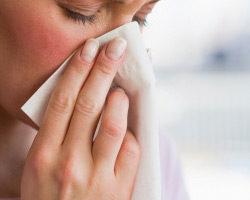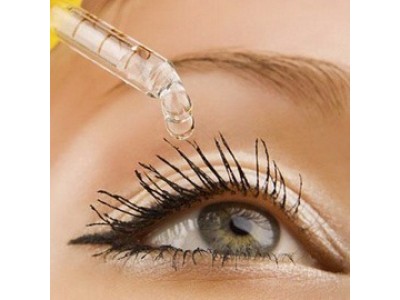 An allergic rhinitis is a protective reaction of the body when it comes into contact with an allergen. It can occur at any age. This disease is widespread. The incidence rate among children reaches 10%. Despite the fact that allergic rhinitis does not endanger the child’s life, the disease requires serious attitude and treatment, since almost every second patient develops bronchial asthma in the absence of treatment. Frequent exacerbations of the disease reduce the protective forces of the child’s body; have a negative impact on the performance of schoolchildren. In the absence or late start of treating, a serious pathology of ENT organs develops. It can be an independent disease, and can be combined with other manifestations of allergy - damage to the skin, bronchi, and digestive organs. Often allergic damage to the nasal mucosa is due to the fact that it is its cells that first contact the allergens that enter the body aerogenically, and acquire increased sensitivity to these substances.
An allergic rhinitis is a protective reaction of the body when it comes into contact with an allergen. It can occur at any age. This disease is widespread. The incidence rate among children reaches 10%. Despite the fact that allergic rhinitis does not endanger the child’s life, the disease requires serious attitude and treatment, since almost every second patient develops bronchial asthma in the absence of treatment. Frequent exacerbations of the disease reduce the protective forces of the child’s body; have a negative impact on the performance of schoolchildren. In the absence or late start of treating, a serious pathology of ENT organs develops. It can be an independent disease, and can be combined with other manifestations of allergy - damage to the skin, bronchi, and digestive organs. Often allergic damage to the nasal mucosa is due to the fact that it is its cells that first contact the allergens that enter the body aerogenically, and acquire increased sensitivity to these substances.
The cause of allergic rhinitis can be a wide range of inhalation allergens:
•Household;
•Plant origin;
•Fungal;
•Food;
•Microbial.
Household allergens can be very different:
•Home dust due to contained in it ticks, tiny particles of tissue, detergents, feathers from pillows, etc.;
•Library dust, the components of which are pieces of cardboard, paper and printing inks;
•Allergens, having an animal origin: dandruff and hair of domestic animals, particles of their secretions, fluff of parrots, pet food.
•Microscopic spores of fungi can also enter into house dust, especially in damp areas with poor ventilation. Often allergies are caused by fungi affecting plants (potatoes, cabbage, carrots, apples, citrus fruits, plums).
The microbial allergy develops in the presence of chronic foci of infection. Allergens of plant origin are found in a variety of plant species: flowers and herbs, fruits, vegetables, algae, trees. The properties of the allergen can be produced by the plants themselves, on contact with them, their juice and pollen. If plants are part of perfume or medicine, the reaction can develop without direct contact with the plant.
It is facilitated by such factors:
•Air pollution;
•Dry hot weather;
•Hereditary predisposition;
•Poor living conditions;
•Hypovitaminosis.
Often when parents have a penchant for this problem, then the children will come across this but there is a way to prevent it. One of the causes of this disease is weak immunity and therefore it must be strengthened from childhood. If a child from childhood contact with animals, dirt, dust, then in adulthood, it is unlikely he will react for these factors.
With the flow and the emergence of exacerbations distinguish such forms of allergic rhinitis:
Seasonal allergic rhinitis: it is characterized by a certain periodicity of development of exacerbations in the same season or month every year:
•Pollen of trees (maple, birch, oak, elm, alder);
•Pollen of cereals (rye, fescue, foxtail, bluegrass, timothy grass, ryegrass, etc.);
•Weeds (ragweed, wormwood, quinoa) - the plants themselves or their pollen;
•Moldy mushrooms, affecting plants.
Year-round allergic rhinitis, for which the seasonality of exacerbations is not typical, symptomatology of rhinitis is noted throughout the year almost constantly:
•Household allergens;
•The allocation of rodents, cockroaches;
•Mold fungi;
•Food allergens (fish, cow’s milk, eggs, honey, etc.)
The most characteristic manifestation of year-round form is nasal congestion. Exacerbated by unpleasant sensations are differences in atmospheric pressure, low air temperature, smoke in the inhaled air (passive smoking), and infection.
The main symptoms of seasonal allergic rhinitis are:
•Abundant rhinorrhea (secretion of liquid mucus);
•Severe itching in the nose;
•Multiple sneezing;
•Irritation of the skin at the nasal passages (due to friction with a handkerchief or fingers);
•Burning sensation in the eyes;
•Itching and swelling of the eyelids;
•Headache.
In some cases, there is no abundant discharge from the nose, and there is a marked violation of breathing through the nose due to severe swelling of the mucosa. The process can extend to the Eustachian tube (connecting the nasal cavity with the middle ear), which is manifested by a feeling of stuffiness and noise in the ears, a decrease in the severity of the hearing.
Reference data for the diagnosis of allergic rhinitis are:
•Characteristic symptoms;
•The presence of allergies in close relatives;
•No evidence of bacterial or viral infection when examined;
•Presence of other manifestations of allergy;
•Increased number of eosinophils (cells that indicate an allergic reaction) in the analysis of mucosal discharge from the nose and in the blood;
•Increased IgE level in the blood and accelerated ESR.
•An allergist can prescribe special tests to determine a specific allergen. The doctor has to differentiate it from other types.
In treating is important to reduce the contact with the allergen. In seasonal form it is recommended to travel with the child in a dangerous period to another locality where there is no allergen plant. For walks and children’s games you need to choose places with no grass, bushes and flowers.
The necessary preventive measures are:
•Regular cleaning of premises to reduce the concentration of inhalation allergens;
•Getting rid of mold, rodents, cockroaches;
•Removal from the apartment of animals, aquariums, birds;
•Getting rid of carpets, feather bedding;
•The inadmissibility of smoking in an apartment or in the presence of a child on the street;
•Withdrawal from the diet of highly allergenic products.
•Medication is aimed at eliminating manifestations of inflammation and preventing relapses. Preparations of general and local action are used.
There are a lot of medications for allergic rhinitis that works differently. Pharmacotherapy includes such components:
1.Antihistamines.
The need for their appointment is associated with the mechanism of development of an allergic reaction. In the presence of hypersensitivity to the allergen and the appearance of contact with it, immune cells produce strong biologically active substances.
One such substance is histamine, which causes the appearance of allergy symptoms by affecting certain receptors. Antihistamines block these receptors and do not allow histamine. There are over 50 preparations of three generations of this group. Preparations of the first generation are now used less often, when it is necessary and the side effect of these drugs - soothing and hypnotic effect. Most often children are prescribed high-performance drugs of the second and third generation with rarely occurring side effects.
2. Cromones.
3. Corticosteroid (hormonal) drugs.
4. Vasoconstrictors.
5. Specific immunotherapy.
6. Homeopathic remedies.
7. Sorbents.
"


